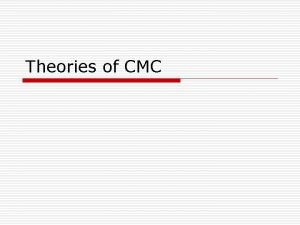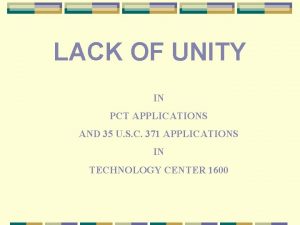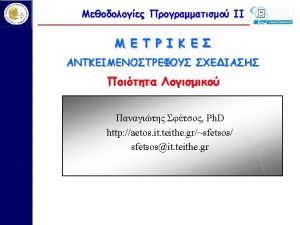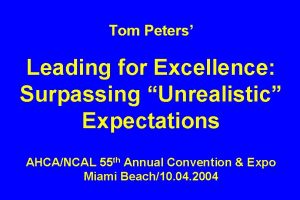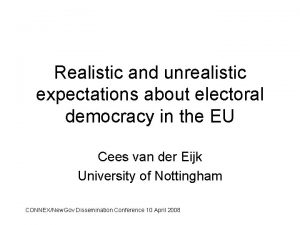Heavy user demand Unrealistic user expectations Lack of

































- Slides: 33


• Heavy user demand • Unrealistic user expectations • Lack of proper resources • Wary of criticism. . . can’t do anything right


Withdrawing to the “IT Fortress: ” Territorialism • Tendency for IT Organizations to build walls • Easy to adopt a defensive stance/siege mentality • Restrict the “peasants” in their freedoms • Subtle feelings of superiority

The reality of other “IT Kingdoms” • Some units have a bad history with Central IT • Mistrust of central authority due to past “misdeeds” (even ten years ago) • Hired their own personnel to gain better control, not be dependent

The reality of other “IT Kingdoms” (cont. ) • Result: Most Central IT Units in academia are not “stand alone” • Pockets of IT Support scattered around the university or college • Might range in size from larger units to pockets of one or two individuals


The Struggle for Power • Many times there exists unhealthy competition between Central IT and these other “IT Kingdoms” • Central IT is seen as domineering and inflexible • Imposing standards • Chargebacks • Irrational policies and procedures • Tendency to conquer and control outside units • Net result is that Central IT is sometimes viewed as the “Evilhearted Overlord, ” who has come to tax and terrorize the countryside


Call a cease fire. . . embrace partnerships with units outside of central IT and introduce an atmosphere of open collaboration while effectively utilizing the collective strengths of all resources.


WVU’s Office of Information Technology • 175 person staff • $30 M budget • Not a resource poor environment

WVU’s Office of Information Technology (cont. ) Historically: • Numerous IT resources outside OIT • Politically stagnant • Lack of IT leadership/vision • No visibility/access

The First Partnership – Admissions and Records • Banner Student Information System • Perfect example of competing units • Finger pointing and worse • No accountability for overall success of the project • The idea of a strategic partnership • Student Systems Development – a joint reporting unit

Immediate Impact – The Partnership between Student Affairs and OIT • WVU Technology Support Center • Student Connectivity Project

WVU Technology Support Center (TSC) • Established by OIT and Student Affairs to assist students, faculty, and staff with all technology needs. • The TSC’s Program Coordinator jointreports to the Director of OIT Customer Support and the Associate Director for Student Affairs Administrative Technology • Merger of OIT’s Computer Service & Repair unit with Student Affairs’ Residential Network Consultants (RNCs)

WVU TSC Services • End-user support for Res. Net users; the TSC handles on-site calls for Student Connectivity • Computer hardware service and repair • Software installation and support • Pre-sales consulting for students wishing to purchase a new computer • Students can purchase a new computer directly from the manufacturer on a web site set up for WVU

TSC Vendor Agreements • The TSC does not sell computers; however, the TSC worked with major computer manufacturers such as Dell, Gateway, IBM, and others to acquire significantly reduced prices on their business-class computers for student purchases • Students can view demo models in the TSC, ask questions of the TSC staff, and even order a new computer on-line directly from the vendor

TSC Locations • Service & Repair area located in the Mountainlair, WVU’s student union, provides convenient access for students on the downtown campus • “Sales” area located in the WVU Bookstore on the downtown campus allows students to purchase computer accessories and peripherals for their new or current computer at the Bookstore • A new service, repair, and “sales” location in the Evansdale Residential Complex will provide convenient access to students living on the Evansdale campus

First Big Test – The Student Connectivity Project • The project’s purpose is to help students get connected to Res. Net, the University’s residence hall network. • First major effort of the combined personnel of the Technology Support Center.

History of Student Connectivity • Started in the Fall of 1997 • Prior to the fall of 2000, Student Affairs managed the project with 10 student employees under the direction of a full-time staff member.

Unprecedented Growth in Student Connectivity

Results of the Unexpected Growth in 1999 • 127 complaints to the Parents’ Hotline • Student Affairs did not finish connecting the “critical mass” of students until the 2 nd week of October • Available Student Affairs resources totally overwhelmed by student demand

TSC Leads First Combined Effort to Address Problem • In addition to TSC personnel, Student Affairs and OIT pooled resources to triage calls, provide advanced phone support, schedule appointments, and handle on-site visits. • In total, almost 50 people from both organizations participated in Student Connectivity 2000. Many volunteered to work weekends and longer hours to ensure the success of the project.


A University Pulling Together In addition to the resources provided by Student Affairs and the departments under OIT (i. e. Academic Computing, Customer Support, Information Systems, and Telecommunications & Network Services), the following organizations contributed resources or offered their assistance to make Student Connectivity 2000 a success! • Extension Service • College of Business & Economics • College of Agriculture, Forestry & Consumer Sciences • College of Engineering & Mineral Resources

Results of the Connectivity Project • NO complaints to the Parents’ Hotline • Almost 3800 students connected in two weeks

Results of the Student Affairs/OIT Partnership • WVU has added new or improved existing services to students through partnerships within the institution • These collaborative efforts allow WVU to accomplish more with limited fiscal and human resources

Subsequent OIT Partnerships • Extension Services • Instructional Technology Resource Center • Office of Research • User Organizations

Dangers of Joint-reporting Operations • Possible ambiguity in delineating roles • Two supervisors giving conflicting instructions/directives • Carving out a joint budget • Us/them attitudes die hard

Benefits of Joint-reporting Operations • Combined resources more effective • Sense of ownership from all parties • Decrease in competitiveness • Presents one “face” to the university community

Lessons Learned • Attitude adjustment begins with me • Executive leadership must be joined at the hip • Strong SLAs • Co-location of the new unit • New leadership of the unit when possible • Quickly erase all vestiges of “us/them” • Keep on top of the partnership • Get word out to the university community and set expectations

For more information, contact: Ken Orgill Chief Information Officer West Virginia University 304 -293 -2550 ken. orgill@mail. wvu. edu Amir Mohammadi Associate VP of Student Affairs West Virginia University 304 -293 -4409 x 2567 amir. mohammadi@mail. wvu. edu
 Ratey method
Ratey method What is demand forecasting and estimation
What is demand forecasting and estimation Inventory modeling
Inventory modeling Mathematical equation ng presyo at demand
Mathematical equation ng presyo at demand Distinguish between individual demand and market demand
Distinguish between individual demand and market demand Measures to correct excess demand and deficient demand
Measures to correct excess demand and deficient demand Independent demand examples
Independent demand examples Dependent and independent demand in inventory management
Dependent and independent demand in inventory management Market demand curve
Market demand curve Module 5 supply and demand introduction and demand
Module 5 supply and demand introduction and demand What is dependent demand inventory
What is dependent demand inventory Single user and multiple user operating system
Single user and multiple user operating system Single user and multiple user operating system
Single user and multiple user operating system Presentation skills means
Presentation skills means Lack meaning
Lack meaning Reduced social cues
Reduced social cues Definition frictional force
Definition frictional force Pct example
Pct example Prqrt
Prqrt Prokaryotic cells lack
Prokaryotic cells lack Lack meaning
Lack meaning Poetry catalog
Poetry catalog Lack of commitment
Lack of commitment Your child's success or lack of success
Your child's success or lack of success Lack of knowledge in teenage pregnancy
Lack of knowledge in teenage pregnancy Inference modal verbs
Inference modal verbs Lack meaning
Lack meaning Criminal addictive thinking
Criminal addictive thinking Lack of cohesion of methods
Lack of cohesion of methods Modals lack of obligation
Modals lack of obligation A lack of voluntary consent:
A lack of voluntary consent: Living together video
Living together video Foliage giving shade
Foliage giving shade Trichomes of blue-green algae lack
Trichomes of blue-green algae lack















